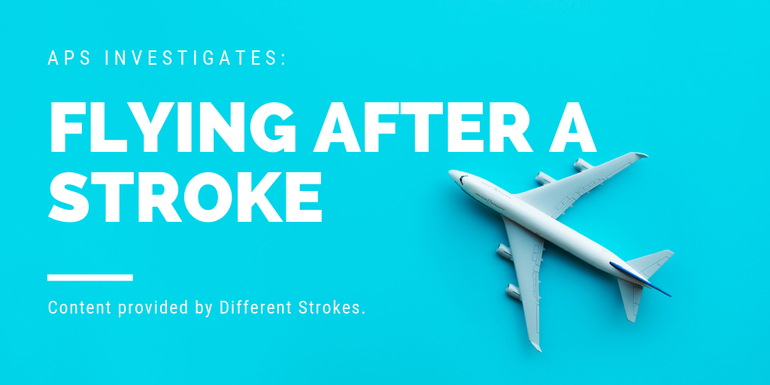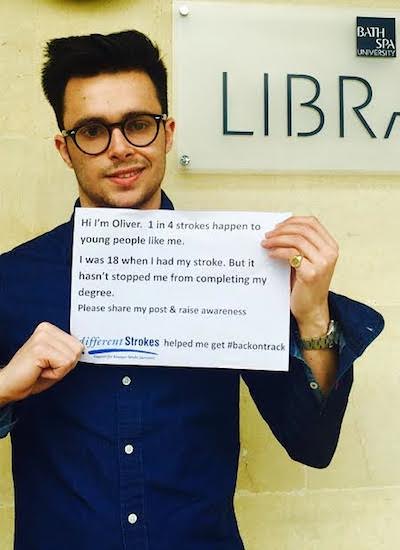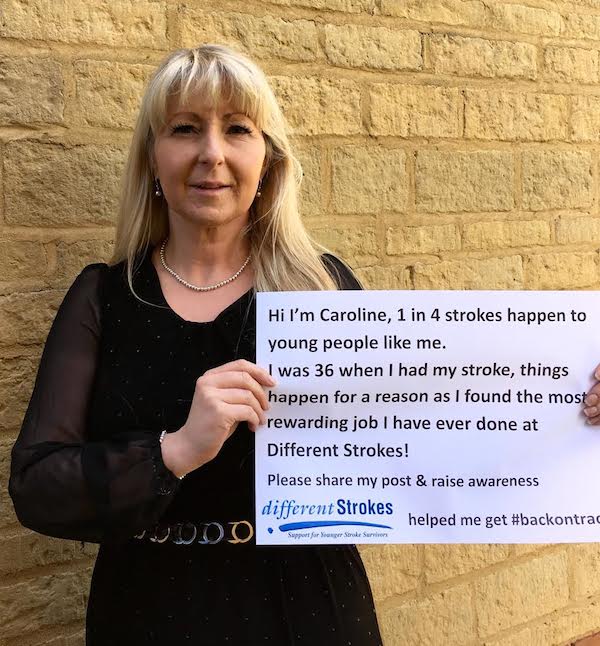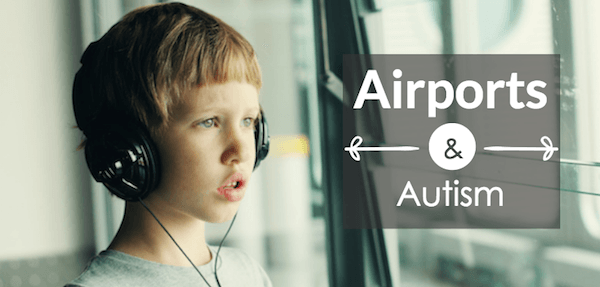Flying after a stroke – The hidden challenges

Content written in collaboration with stroke charity Different Strokes.
Over the years, we’ve written many health and travel articles, including Autism, Diabetes, Sensory Impairments and Mental Health. These were usually through our own research, conducting surveys and the like, but when it came to travelling after a stroke, we wanted to work with Different Strokes.
They provide active peer support for young stroke survivors and families and have kindly written the following piece to shed some light on the hidden challenges that some stroke survivors encounter at airports and when flying. You’ll also hear from stroke survivors and their experiences of flying after a stroke.
With that, let’s hand over to Different Strokes to bring your their insight into flying after a stroke.
Flying after a Stroke: the challenges
Did you know that there are around 1.2 million stroke survivors in the UK? Every year there are 152,000 new cases and at least one in four happens to somebody of working age or younger, so it’s no wonder that Stroke is a leading cause of disability in our nation.
Disabilities can be visible or invisible and include paralysed limbs, anxiety and severe fatigue. There can also be difficulties communicating and processing information; including conditions like Aphasia which affects the production of speech and the ability to read or write.
Another difficulty which can arise after a Stroke is Dysarthria, a motor speech disorder, which can result in slow or rapid speech, mumbled speech and also limited jaw movement. Both of these conditions can make the airport experience extremely difficult and confusing for those involved.
People often ask when it is safe to fly after a stroke. The Aerospace Medical Association Guidelines (2003) suggests:
It is safe to fly once 2 weeks have passed after a stroke.
Airlines, however, have different guidelines as to when they allow stroke patients to fly. The British Airways website states:
“If your symptoms are stable or improving and you feel well enough, you can travel after 3 days. Please talk to the Passenger Medical Clearance Unit (PMCU) if you have had a stroke within the last 10 days.”
Airlines may require the completion of a Medical Information Form (MEDIF), which is available from the medical department of the airline or a travel agent. Our advice would be to check with your own doctor initially who will have knowledge of your medical history, including the cause and severity of your stroke, along with any other underlying medical conditions that may cause a problem. You should always inform your travel insurance about your stroke and about any medications that have been prescribed as a result.

Airport Assistance for those flying after a stroke
Airports have a legal obligation under EU Regulation 1107/2006 to assist disabled travellers. All European airports should have facilities to help you move through the airport and get on and off the plane if you have a sensory, physical or learning disability which affects your mobility. Contact the airline to discuss your requirements, including any additional help you will need on the flight, at least 48 hours in advance. Your airline will then pass your request to the relevant airport and staff who will provide the assistance before you step on to the plane. See more at Gov.uk
One passenger Sam Lambert describes his experience travelling with a relative with limited mobility:
“There are three types of assistance possible; the first is suitable if you require help walking distances, but are able to climb steps and make your own way to your seat on the aircraft; the second should be booked if you find climbing steps difficult; and the third provides wheelchair assistance right to your seat, with the use of an on-board wheelchair. It’s important to book the right assistance, as different codes are assigned to your booking depending on which you choose.
For all options, you can either use the airport wheelchairs or if you’re a wheelchair user and would prefer your own chair, you can check it in and keep using it right to the aircraft door at some airports. It’s then brought up to the door of the aircraft at your destination. Clarify this with the airline as not all airports allow you to keep your own chair, though most large airports do.
Once at the airport an immediate hurdle was the scenario of getting from the drop off point to the check-in desk. Our confusion was due to a lack of information from our airline and I was later told by one of the attendants that this lack of information is common across all airlines. Airlines do promote assistance but we found that simple logistics weren’t communicated.
My advice would be to contact the airports you are using regarding drop off arrangements. An important distinction is that airport assistance is run by, or on behalf of, the airports themselves, not your specific airline. Speak with the airport and ask how you let the staff know to come and collect you when you arrive. At Gatwick, for example, there is a specific area where you press a call button and make the team aware you’re waiting. It’s well signed, but only if you know it’s there in the first place.
If you’ve booked assistance you and any travelling companions are given priority at check-in, security and on boarding and the whole experience is guided. We moved through our departure airport with ease. Once you arrive at your destination assistance will meet you and ensure you are taken through the airport and its formalities. They will stay with you right up until you get into your onward transport. We found this to be brilliant.
What struck me most is how booked assistance alleviates many of the wider stresses of the airport. This is important not only for those with a physical disability but also for those who have all forms of other disabilities, such as neurological disabilities.”
What other stroke survivors have to say
We asked other younger stroke survivors for their experiences of special Airport Assistance for physical disabilities and are pleased to report that they were generally positive:
“The first time we flew since my wife’s stroke, we booked airport assist through our tour operator. It was fantastic, they took us straight to the front of the queue at check in and helped us all the way to getting us seated on the plane. We’ve done it a few times now – it’s been brilliant and saved my wife loads of hassle.”
“Flying is easy, you need to book for assisted passage. I keep my own wheelchair right to the gate, you will be offered one so that they can put your chair into baggage but I won’t let them do that, I like my own chair. The bonuses are that you get through straight through security, customs and border controls, though they may search you with a dog. You are first on the plane and last off, but again you are led to the front of the queues.”
“It’s a lot easier than you might think, much better than my experiences on the train! I flew to Italy a year after my stroke with my wife. Walking ‘the plank’ between the Ambi-Lift and the plane felt a bit precarious the first time, but a couple of months later I braved a trip to Tenerife on my own. In all of the airports, it has been dead easy. I have been met at the door and delivered to my seat on the plane by the same person.”
“Post stroke I still fly about 4 long haul trips per year and, in general, it is now easier getting through airports than before. Book assistance if like me, you have mobility issues or are faced with a long walk to the gate. If using a walking stick, ensure that it is a collapsible type and a true walking stick rather than a pole. My pole was confiscated once in the US as ‘ski equipment’ (I wish!) and was not allowed on board. It was given back to me once we landed and during the flight I found getting to and from the loo easy enough using the back of seats as hand holds.”

Is There Airport Assistance for Non-Physical Disabilities?
However, disabilities after stroke can also include an inability to speak or be understood, lack of concentration, poor vision, no short term memory, difficulties processing information and background noise, depression, anxiety, severe fatigue and uncontrollable laughter or tears.
So what if your disabilities aren’t visible, or aren’t physically severe enough for you to be using a wheelchair or walking stick? Airport and airline special assistance guidelines seem to focus solely on mobility issues and visual/hearing impairments which deters some stroke survivors from even asking if they therefore qualify for assistance:
“I found it a bit of an ordeal checking in with nowhere to sit down when travelling on my own. Again at security check when the guy gets everything out of your hand luggage, then expects you to put it back with one hand! To get assistance, you have to be fully disabled and not just partially impaired.”
“I haven’t used an airport since I had the stroke. Travel is a bit hit and miss at the best of times. I found people were pretty good when I was using a stick, but pushed me out of the way when I wasn’t. I guess you need an obvious sign that you are struggling.”
And, as other members put it;
“I can’t see airports would be good for people recovering from stroke with no physical disability.”
“If you don’t have an obvious disability you get no help and the staff hurry you as they are trying to process you as quickly as possible. It is hard to remove shoes, remove belt and repack your bag if something is spotted on the scanning machine. Are you entitled to help if you are apparently ok, and don’t need a wheelchair or a walking stick? If the answer is ‘yes, you can get help’, then this written in black and white would be useful.”
“There is a need to provide assistance to those, like me, who have no visible disability. Airports are one of my worst nightmares now. Standing in a security queue and trying to process all the stuff going on generally just reduces me to the point of fear sometimes.”
The Autism Awareness Approach – a possible solution?
Manchester Airport has a scheme which fast-tracks children with autism through security to make travelling easier for them and their families. The airport launched the scheme after recognising that those with the condition can find it a ‘confusing and frightening experience’. Parents can contact the airport ahead of their trip to get a booklet – specific to each terminal – and a video giving children a step-by- step guide of what they can expect. Once families confirm to the airport that their child is on the autism spectrum, they will be given a wristband to wear at the airport to alert staff. Take a look at our Airports and Autism article for more information.

The notion of a ‘confusing and frightening experience’ will strike a chord with many stroke survivors, particularly those whose disabilities are non-physical. The question therefore to be asked is whether the same could be done for stroke? Training for staff and a special passenger wristband or carry card system could alert airport staff that a traveller may have difficulties processing information or background noise, may have communication problems, may not look physically disabled but may be too fatigued to stand in queues for long periods, or may be simply left feeling vulnerable as a result of stroke. Would airports be willing to work with us to improve the whole airport experience for those stroke survivors who are struggling with the non-physical aspects of stroke?
Have you been affected by a stroke or are you considering flying after a stroke? Get in touch with Different Strokes today:
info@differentstrokes.co.uk / 0845 130 7172.